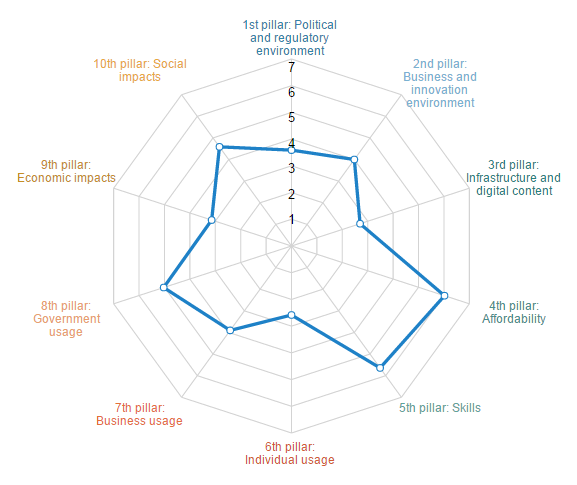5 things to know about Sri Lanka’s economy
Stay up to date:
The Digital Economy
As Sri Lanka goes to the polls, only seven months since Maithripala Sirisena won the last parliamentary election in January 2015, we take a look at five trends that tell us how well the economy of the island nation is performing.
- A competitive edge. Sri Lanka’s economy should grow by 7% this year, up from 4.5% last year. Meanwhile, inflation is predicted to end the year far below market expectations, according to Finance Minister Ravi Karunanayake. There are even signs that the nation is investing in the infrastructure required to make it an economic hub in South Asia. In the World Economic Forum’s Global Competitiveness Index 2014-15, Sri Lanka ranked 73 among 144 countries, placing it ahead of other emerging economies such as Kenya, Greece and Ukraine. This sees it move up three places since 2012-2013, when it ranked at 65 for a range of criteria including infrastructure, education and business sophistication. This graph shows Sri Lanka’s competitiveness breakdown for 2014-2015:
Source: The Global Competitiveness Report 2014-2015
- Education leads the field. Sri Lanka’s literacy rate is 92% – higher than anywhere else in Asia, and especially high for a developing country. As a measure of how effectively it has promoted education overall, the country ranks 28th out of 124 nations, sitting squarely within the global top third for the quality of its primary schools. In addition, the gender gap at secondary and tertiary levels is almost non-existent, according to the Human Capital Report 2015, an achievement that wins the nation first place on the 2015 index when it comes to equality among the young.
Source: Human Capital Report 2015
- Digitization develops apace. The country comes 65th out of 143 countries globally for network readiness, according to the Forum’s Global Information Technology Report 2015. This is up from 76th position last year, and places it ahead of Greece, Mexico and South Africa. In terms of skills necessary for digital progress, it ranks even higher, at number 30. Again, this is predominantly down to the compulsory nature and quality of the state education system and high level of adult literacy. This graph shows how Sri Lanka is performing on criteria related to network readiness:
Source: Global Information Technology Report 2015
- It’s a destination nation. According to the Forum’s Travel & Tourism Competitiveness Report 2015, the Sri Lankan government has done a great job of promoting and orchestrating the travel sector. For effectiveness of branding to attract tourists, the country scores 5.4 out of a possible 7, placing it in the top quarter of all 141 countries surveyed (at number 22). It’s a huge leap from 2013, when it appeared much further down the global index, at number 76. This graph shows Sri Lanka’s 2015 performance in the travel and tourism sector, with a particularly strong showing in the areas of price competitiveness and safety.
Source: Travel & Tourism Competitiveness Report 2015
- The gender gap is widening. Striking a less encouraging note, Sri Lanka has slid down a long way from the giddy heights of 1960, when it appointed the world’s first democratically elected female prime minister. Since 2006, political empowerment among women has dipped from an impressive sixth place to a less inspiring 50th position today, according to the World Economic Forum Global Gender Gap Report 2014. The male-female ratio among young people enrolling in secondary and tertiary education still strikes an exemplary balance, but the percentage of women taking roles in parliament hasn’t risen above 6.5% since 1948. Currently, only 13 out of 225 parliamentary members are female. This graph shows the downward trajectory of female political empowerment since 2006:
Source: Global Gender Gap Report 2014
Have you read?
How mobiles help Sri Lanka fight climate change
Can Sri Lanka join the knowledge economy?
How can we spur growth in Sri Lanka?
Author: Anna Bruce-Lockhart is an editor at the World Economic Forum.
Image: A man shows his ink-stained finger after casting his vote at a polling station during the first provincial polls in 25 years in Jaffna in northern Sri Lanka, about 400 kilometres (249 miles) north of Colombo September 21, 2013. REUTERS/Dinuka Liyanawatte
Don't miss any update on this topic
Create a free account and access your personalized content collection with our latest publications and analyses.
License and Republishing
World Economic Forum articles may be republished in accordance with the Creative Commons Attribution-NonCommercial-NoDerivatives 4.0 International Public License, and in accordance with our Terms of Use.
The views expressed in this article are those of the author alone and not the World Economic Forum.
Related topics:
Forum Stories newsletter
Bringing you weekly curated insights and analysis on the global issues that matter.
More on Economic GrowthSee all
Atul Kumar
August 12, 2025
Elizabeth Henderson and Daniel Murphy
August 8, 2025
Li Dongsheng
July 31, 2025
Charlotte Edmond
July 30, 2025
Naoko Tochibayashi
July 30, 2025
Matt Watters
July 29, 2025










